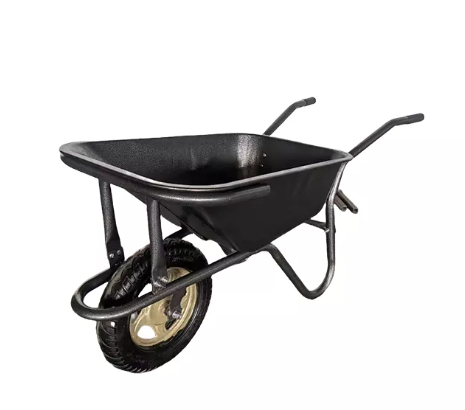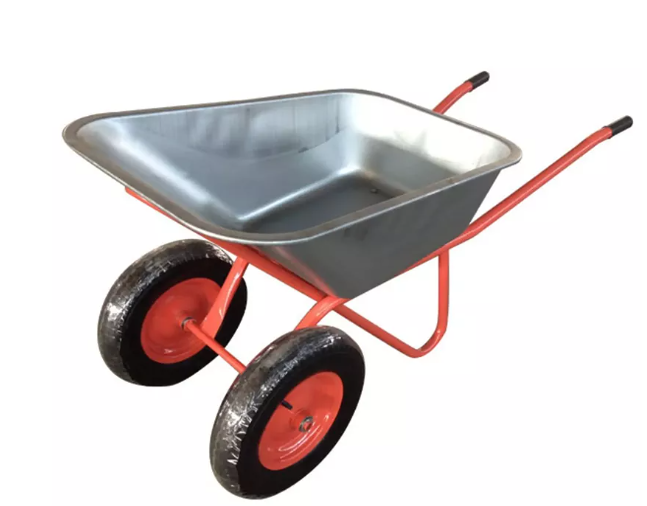- All
- Product Name
- Product Keyword
- Product Model
- Product Summary
- Product Description
- Multi Field Search
Please Choose Your Language
Views: 0 Author: Site Editor Publish Time: 2025-06-11 Origin: Site









When working on construction sites, having the right equipment can make all the difference in productivity, safety, and efficiency. One of the most commonly overlooked but essential tools on any construction project is the wheelbarrow. A high-quality wheelbarrow is vital for transporting materials such as soil, bricks, and concrete, making the work faster and less physically demanding. This post will explore the various types of wheelbarrows used in construction, helping you choose the best option for your needs. We will cover the key factors to consider when purchasing a wheelbarrow and answer frequently asked questions to guide your decision.
In construction, wheelbarrows are used to move materials efficiently across the site. Different types of wheelbarrows offer various features, such as load capacity, maneuverability, and stability, which make them suitable for different tasks. Whether you're transporting light garden materials or heavy construction debris, selecting the right wheelbarrow is essential for the job.
Single-wheel wheelbarrows are the classic design commonly used on construction sites. Featuring one wheel, they provide excellent maneuverability, making them ideal for navigating through narrow spaces or around obstacles. These wheelbarrows are often smaller and lighter, which makes them easier to turn and handle in tight areas.

Single-wheel wheelbarrows are typically used for transporting small quantities of materials such as cement, tools, and construction waste. Their compact design allows them to be used in confined spaces or uneven terrain, making them perfect for intricate tasks where maneuverability is key.
Advantages: Easy to maneuver, perfect for tight spaces, compact design, suitable for light to medium loads.
Disadvantages: Requires good balance from the operator, lower load capacity compared to dual-wheel wheelbarrows.
Dual-wheel wheelbarrows feature two parallel wheels, offering more stability when moving heavier loads. This design helps distribute the weight evenly, reducing the risk of tipping over, especially when transporting larger quantities of material.
Dual-wheel wheelbarrows are ideal for hauling larger, heavier materials such as sand, gravel, bricks, and soil. The added stability makes them a great choice for transporting materials over uneven or rough terrain, and they are often used for tasks that require steady control.
Advantages: Better stability, higher load capacity, less chance of tipping, easier to load and unload heavy materials.
Disadvantages: Less maneuverable in tight spaces, may require more effort to turn or navigate around obstacles.
Electric wheelbarrows are powered by electric motors, reducing the physical effort needed for transporting heavy materials. These wheelbarrows can be controlled with ease and often feature adjustable speed settings, making them suitable for large-scale construction projects that require long-distance transportation of materials.
Electric wheelbarrows are ideal for heavy-duty tasks that involve moving large amounts of material, such as concrete or large building components, across large construction sites. They are especially beneficial on projects that require frequent material hauling over extended distances.
Advantages: Reduces physical strain, excellent for long-distance hauling, faster transport.
Disadvantages: Requires charging, more expensive than traditional wheelbarrows, may require maintenance.
Remote-controlled electric wheelbarrows represent the latest innovation in construction wheelbarrow technology. These wheelbarrows can be operated from a distance using a remote control, allowing workers to move large loads without manual effort. They come with features like hydraulic lifting systems and self-dumping capabilities, making material handling significantly easier.
These advanced wheelbarrows are particularly useful for complex or hazardous environments where manual labor might be limited. They are ideal for heavy-duty material handling on construction sites with rough terrains or limited manpower.
Advantages: Hands-free operation, great for hazardous or complex environments, high load capacity, self-dumping feature.
Disadvantages: Expensive, requires training to operate, may not be necessary for smaller construction projects.
Choosing the right wheelbarrow depends largely on the type of construction project you're working on. The nature of the materials you need to transport, the size of the construction site, and the terrain you'll be working with all play a role in selecting the best wheelbarrow.
For tasks that require transporting heavy materials such as concrete, bricks, or large quantities of gravel, dual-wheel or electric wheelbarrows are your best option. These wheelbarrows can carry larger loads and handle the demands of tough construction tasks, improving efficiency and reducing physical strain.

If your construction site has narrow spaces or complex terrains, a single-wheel wheelbarrow is ideal. Its compact design allows for better maneuverability, helping you navigate tight areas and uneven surfaces with ease.
For large construction sites requiring the transportation of materials over long distances, electric or remote-controlled wheelbarrows are perfect. These wheelbarrows minimize the need for physical effort and allow you to move materials more efficiently over extended distances.
For smaller construction projects or residential work like garden renovations or home building, single-wheel or dual-wheel wheelbarrows are cost-effective and efficient for handling lighter loads.
When choosing a wheelbarrow for construction, several key factors will determine which option is best for your needs. Understanding these features will help ensure you select a wheelbarrow that will be both efficient and durable on the job.
Make sure the wheelbarrow you select has the appropriate load-bearing capacity. For large construction projects, a wheelbarrow with a capacity of 6-10 cubic feet is ideal for handling heavy materials like concrete and dirt.
Steel Wheelbarrows: These are durable and ideal for heavy-duty use but can be prone to rusting over time.
Plastic Wheelbarrows: Lighter and more resistant to rust, but may not be suitable for carrying heavy loads.
Pneumatic Tires: Great for rough terrain as they absorb shocks, making transport smoother and reducing wear.
Solid Tires: Maintenance-free but can provide a less smooth ride, better suited for even surfaces.
Single-Wheel: Highly maneuverable, ideal for tight spaces, but requires better balance from the operator.
Dual-Wheel: Offers more stability but is less maneuverable in narrow spaces.
Ergonomic handles can reduce strain, especially during long hours of use. Make sure to choose a wheelbarrow with handles that are comfortable to grip and appropriate for the height of the user.
Steel frames are more durable but may require regular maintenance to prevent rust. Plastic frames, while lighter, are more corrosion-resistant but may not handle as much weight.
When purchasing a wheelbarrow for construction, consider the following tips:
Test Before You Buy: If possible, test the wheelbarrow before purchasing to assess its maneuverability, stability, and overall ease of use.
Consider Storage and Transport: Wheelbarrows come in various sizes, so choose one that can be easily stored and transported, especially if you have limited space.
Budget Considerations: Consider your budget. High-tech options like remote-controlled wheelbarrows are more expensive, but simpler models may meet your needs for lighter tasks.
Choosing the right wheelbarrow for your construction project is crucial for maximizing efficiency and ensuring safety on-site. By considering factors such as load capacity, terrain, and the nature of your work, you can make an informed decision that enhances productivity. Whether you opt for a single-wheel for maneuverability, a dual-wheel for stability, or an electric option for heavy-duty tasks, the right wheelbarrow will make a significant impact on your worksite.
A: A dual-wheel or electric construction wheelbarrow is ideal for heavy-duty tasks such as transporting bricks, cement, or large quantities of sand.
A: While single-wheel wheelbarrows are more maneuverable, they generally have lower load capacities compared to dual-wheel models. They are best suited for smaller loads on rough or narrow terrain.
A: Electric and remote-controlled wheelbarrows significantly reduce physical strain and improve efficiency for large construction sites where heavy loads need to be moved over long distances.